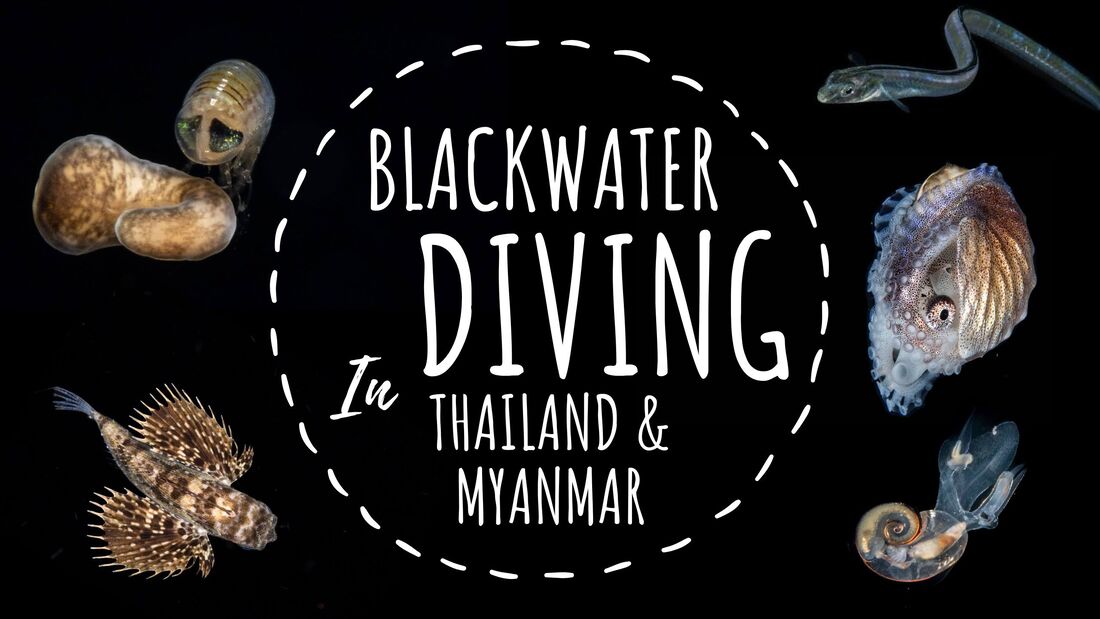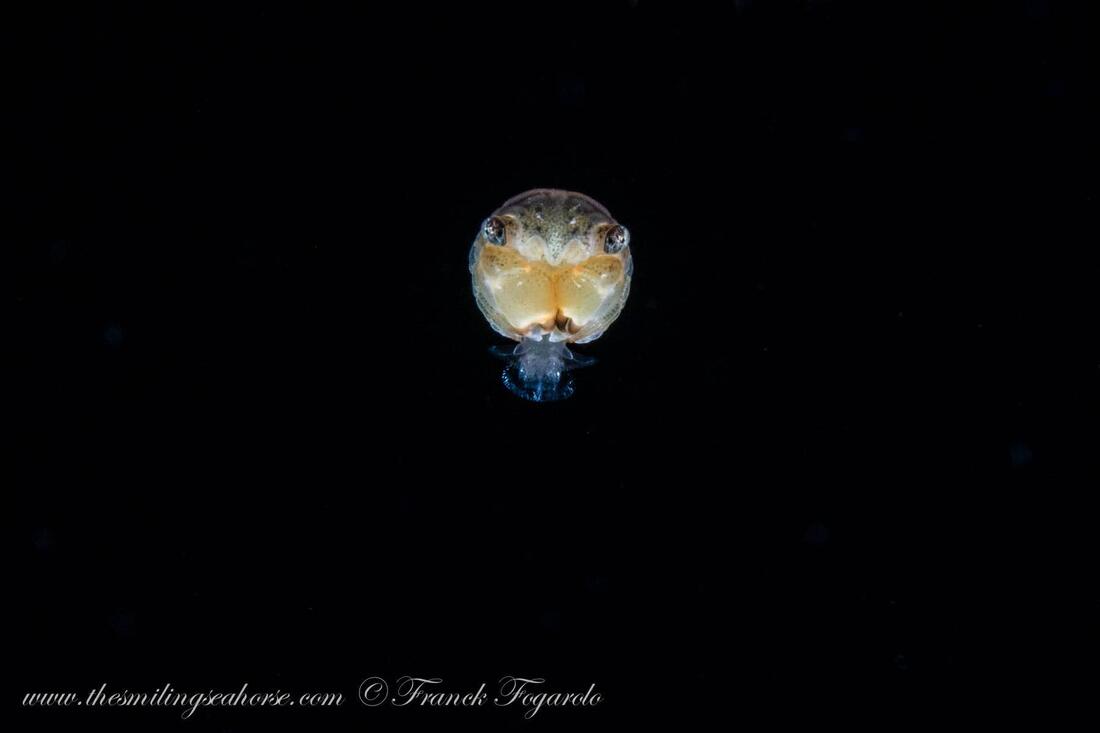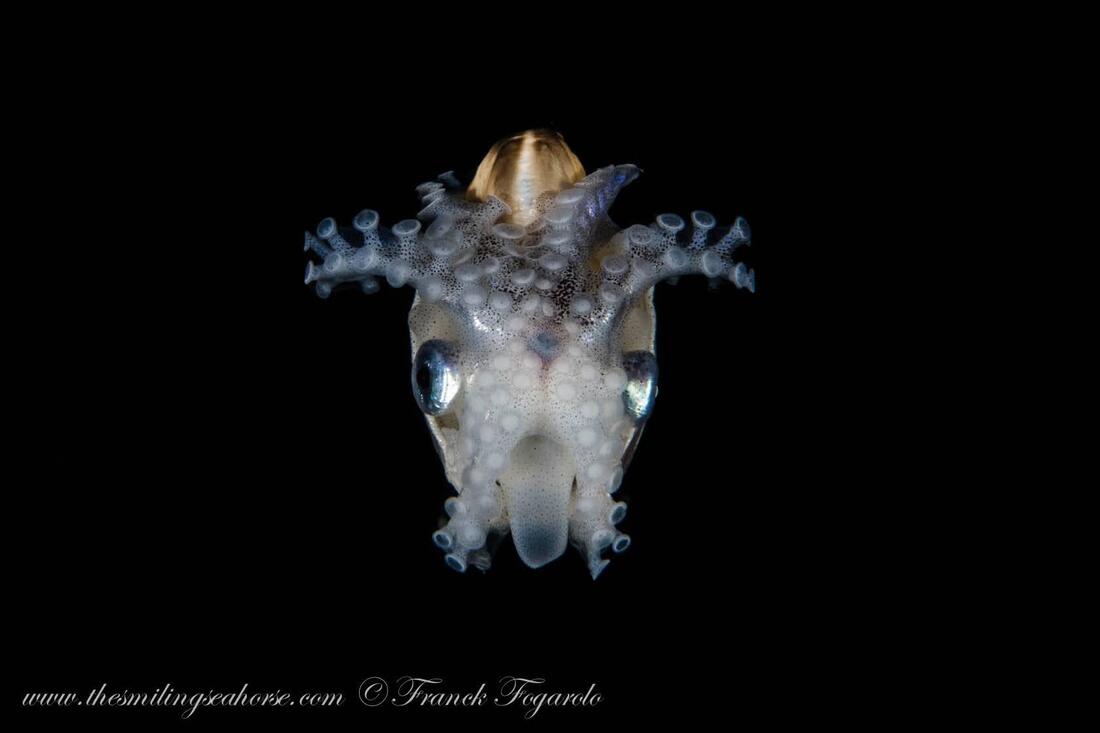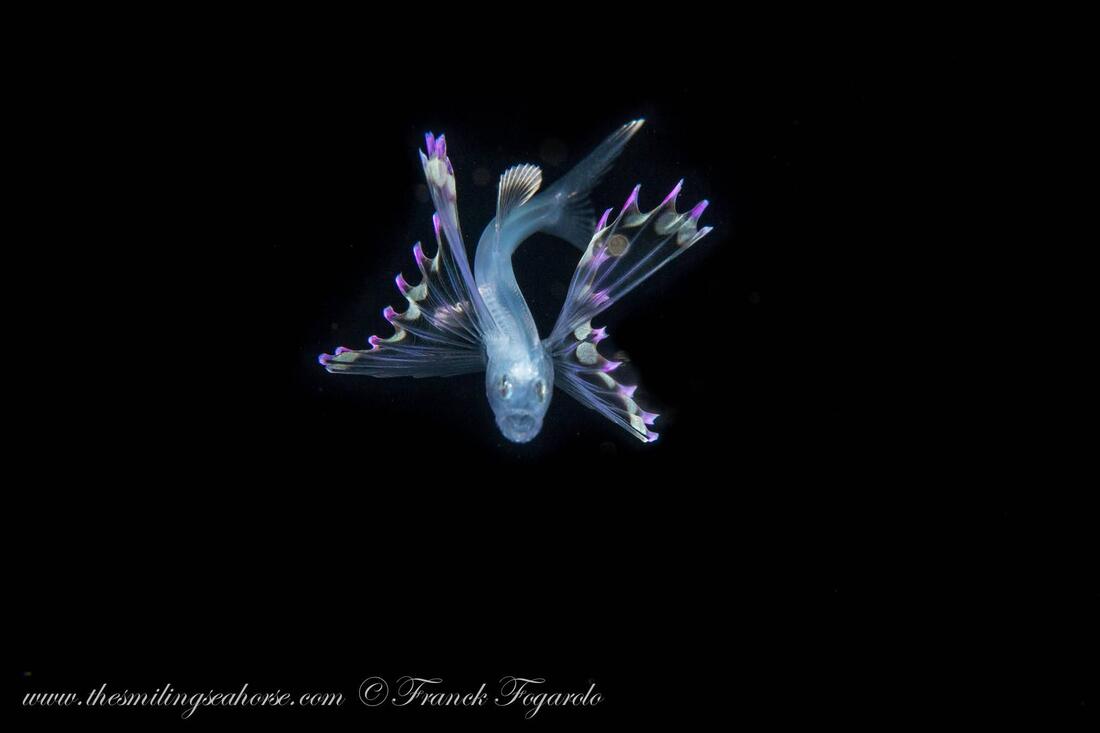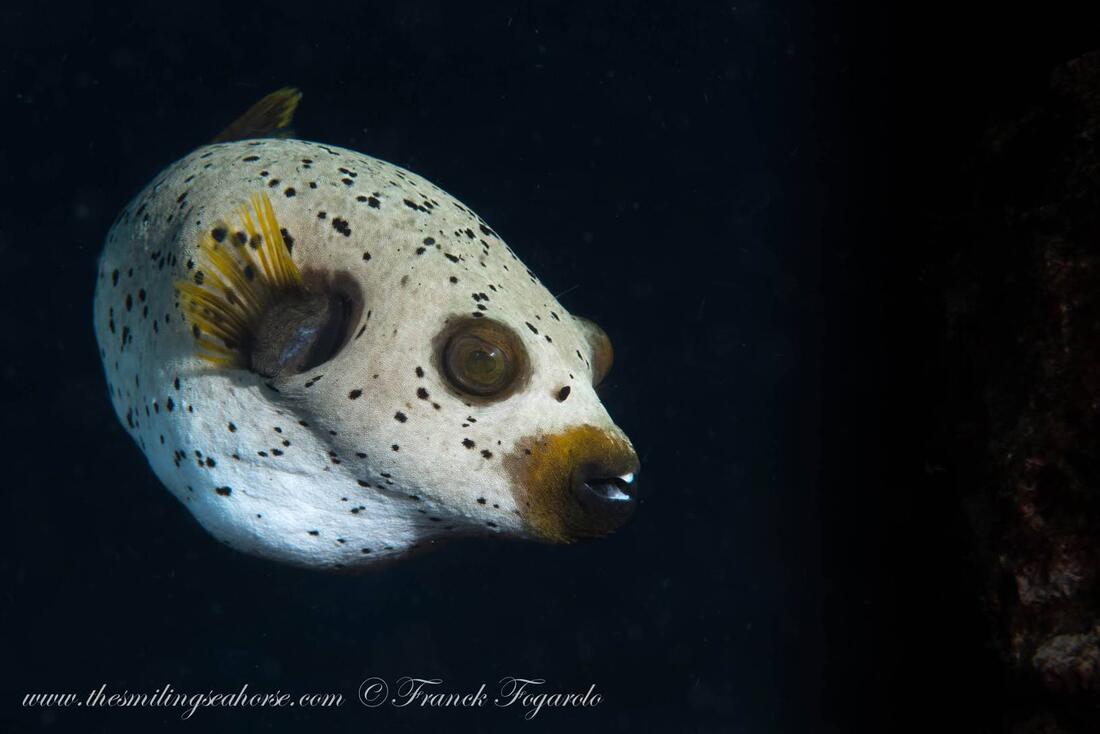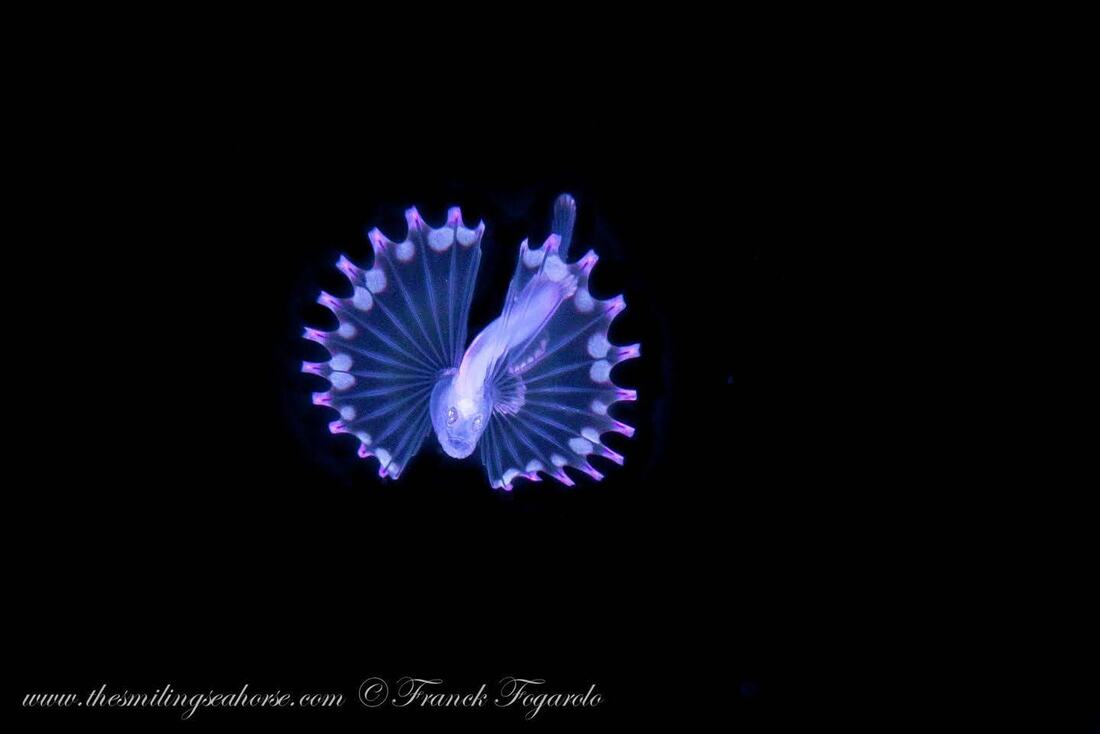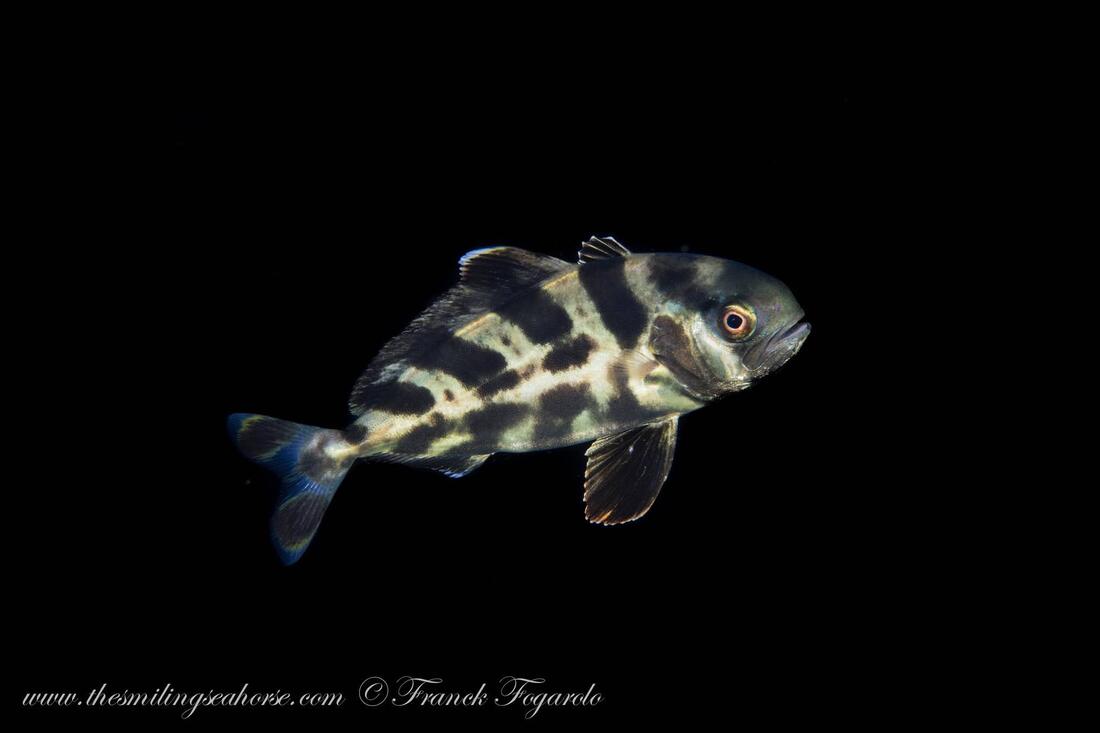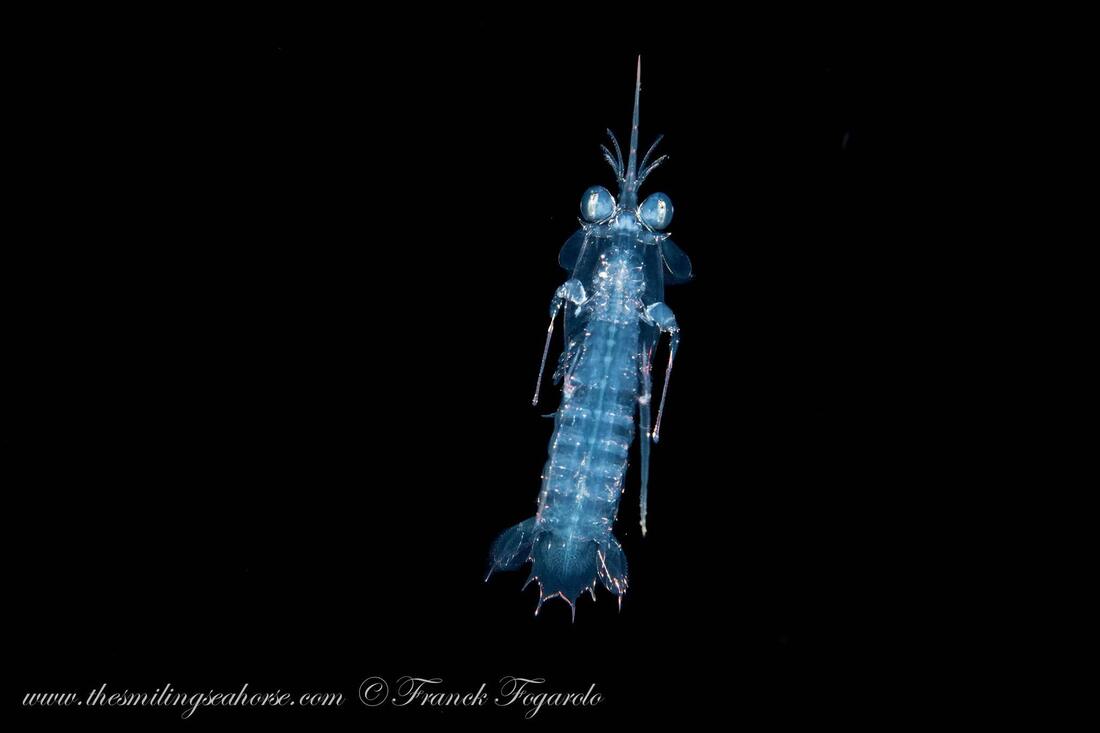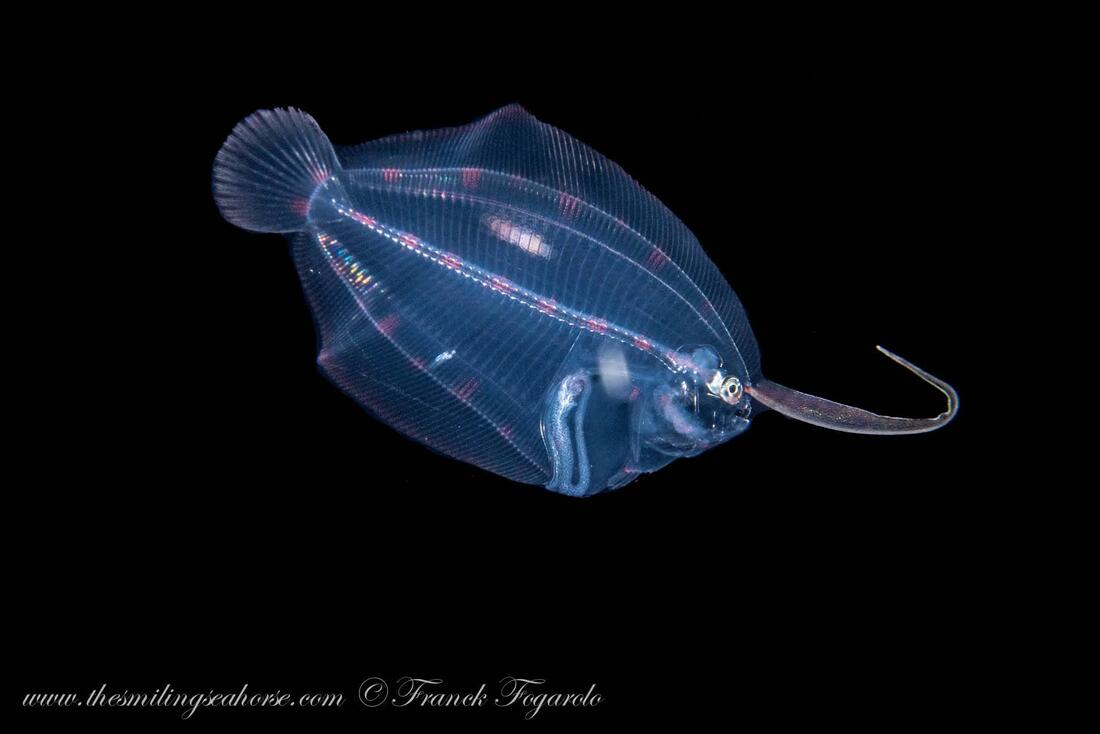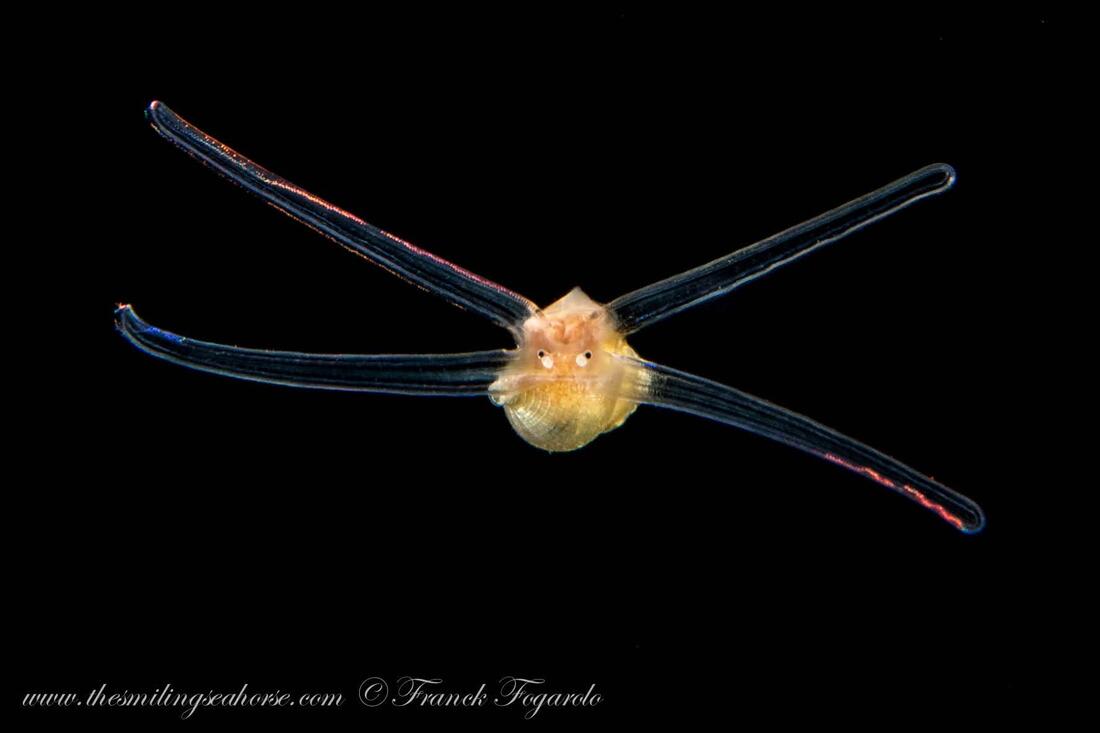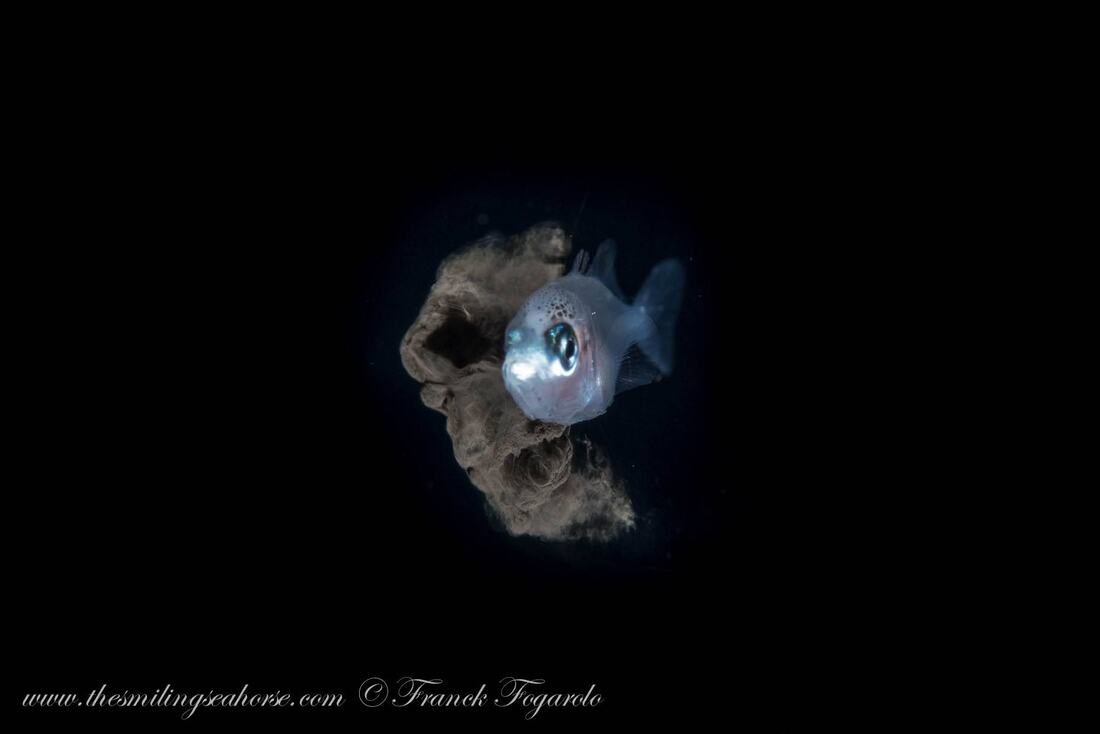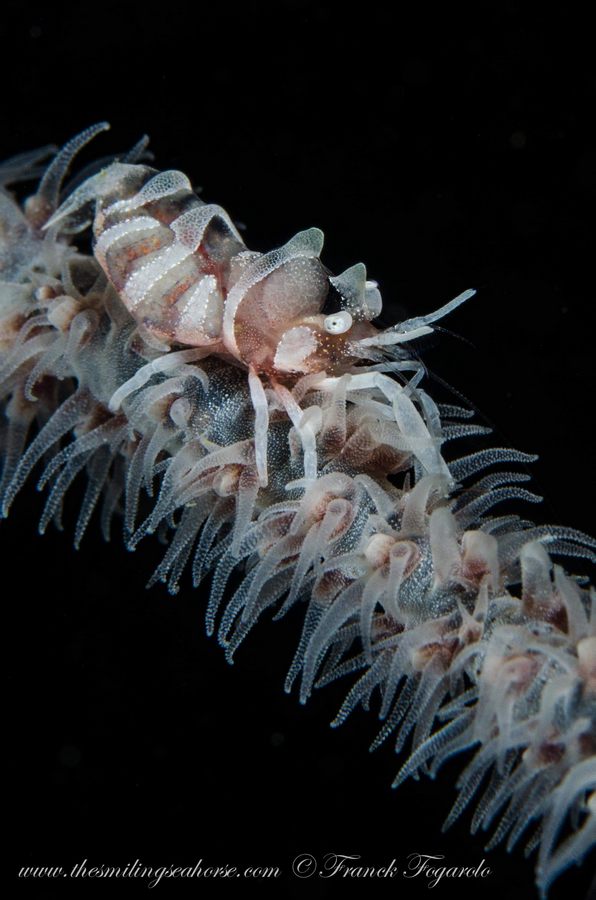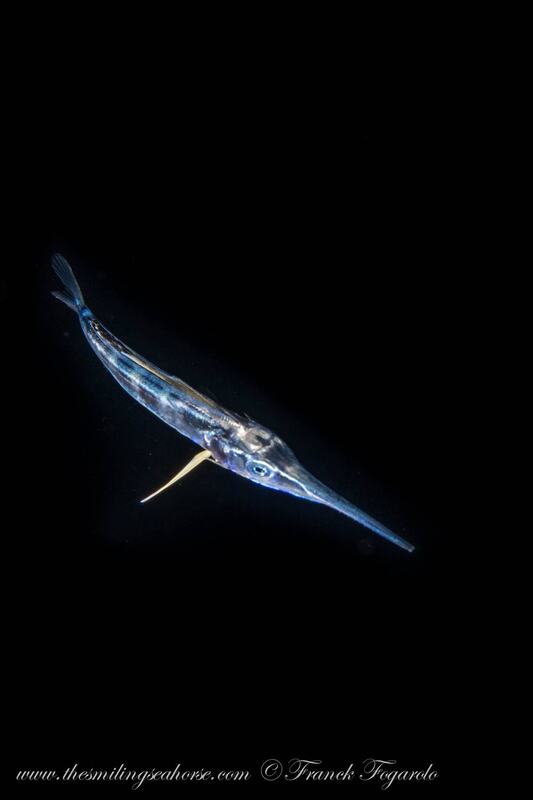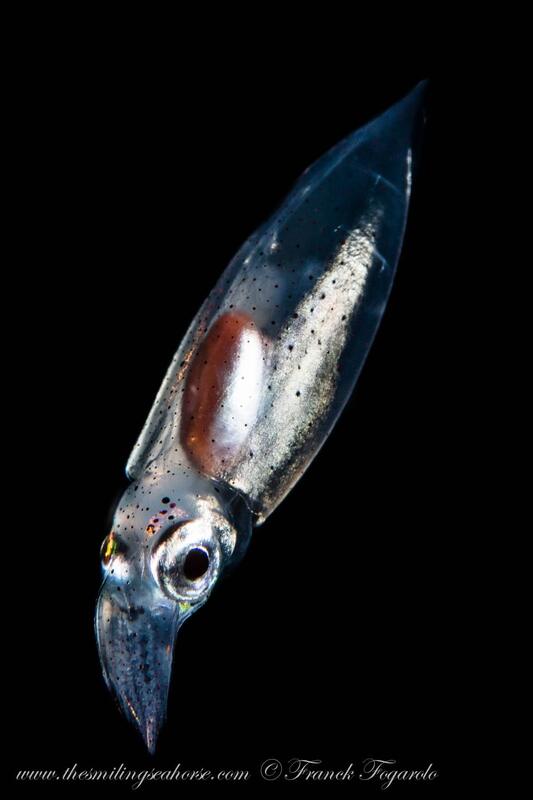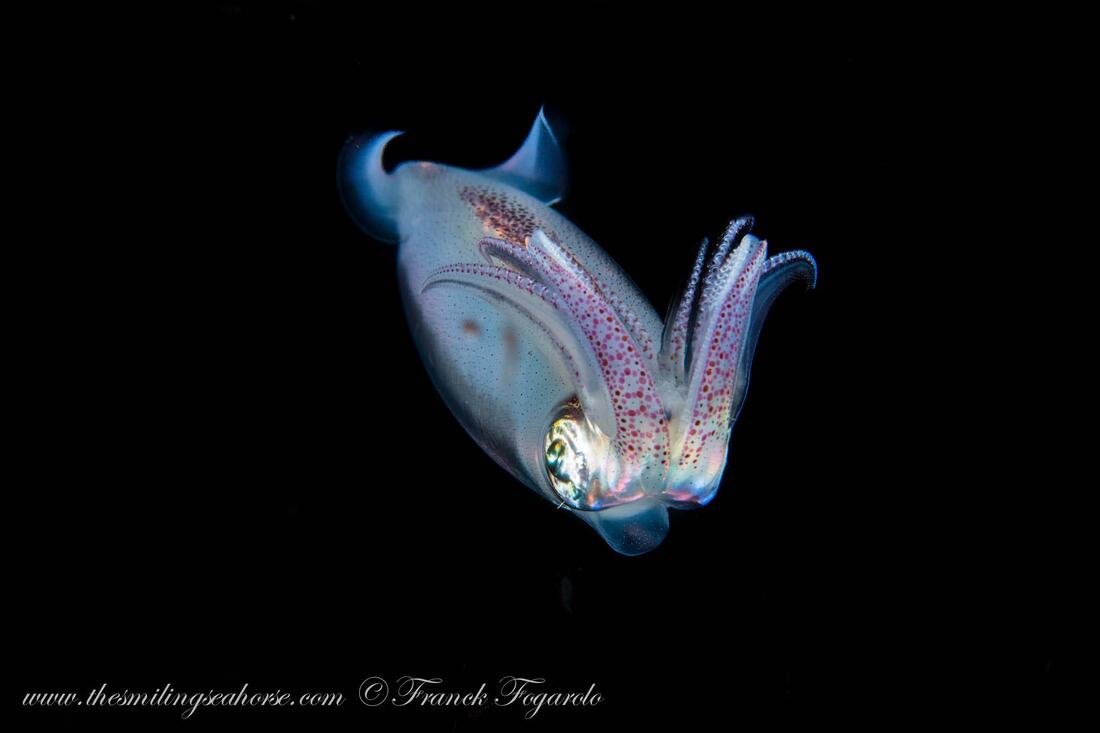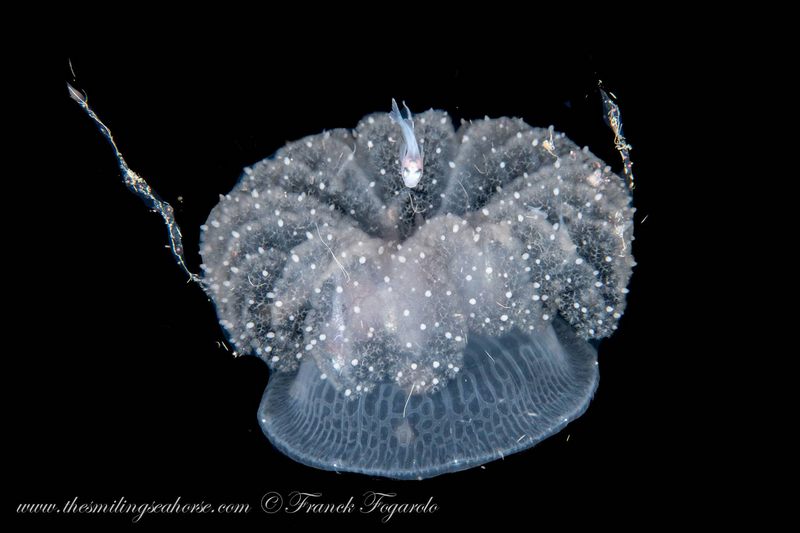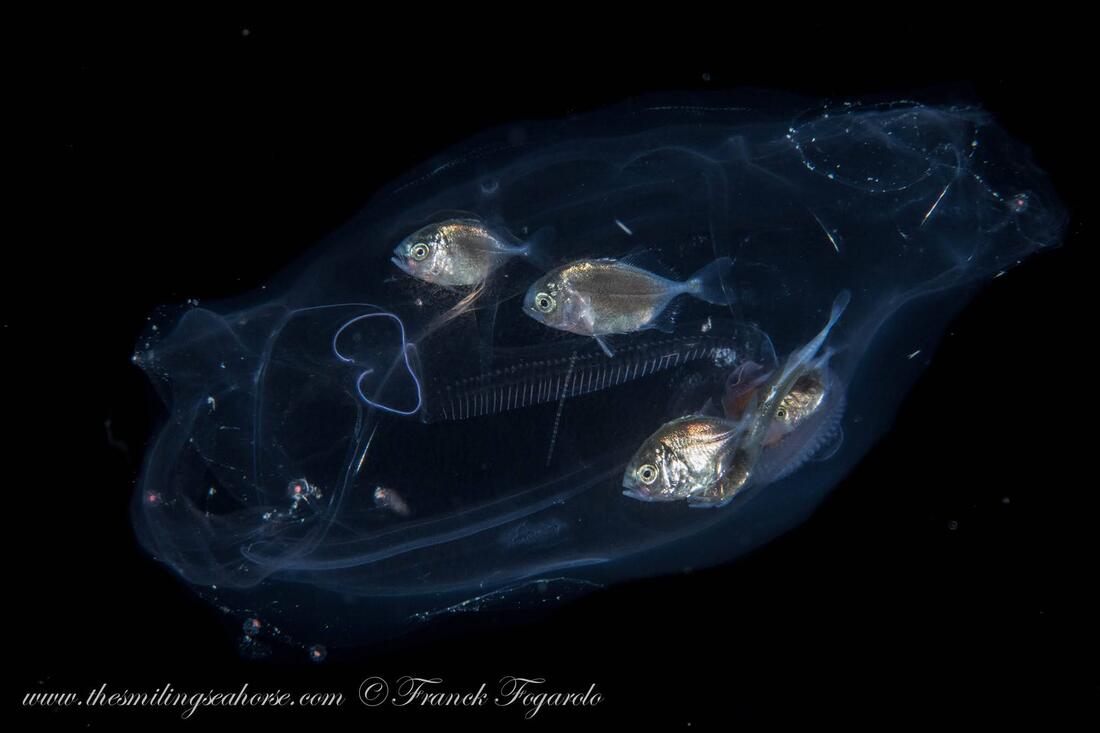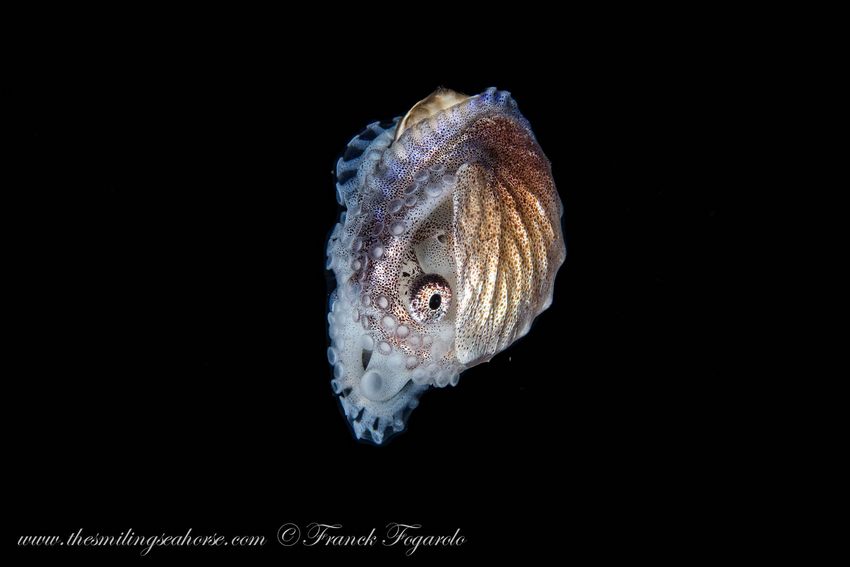Blackwater diving in Thailand and Myanmar
Have you ever tried Blackwater diving in Thailand or Myanmar?Although I now heard of Blackwater diving for a few years, it is not yet developed in Thailand and I only tried it for the first time 2 years ago from our boat in Similan islands (Thailand), and guess what?... I LOVED it!
Since the borders of Burma reopened, we have done wonderful Blackwater dives there... just as magical as our first blackwater dives in Thailand!!! |
After 20 years of diving, it totally blew my mind! A whole new world of weird little monsters was opening up to me.
Let's say I got lucky, but on my second blackwater dive ever, I encountered a Juvenile Sailfish. How cool is that?
Since that first time, I was desperate to reiterate and did another 6 blackwater dives before the diving season in the Andaman Sea came to a halt.
What did I see on these 4 dives? A super cool paper Nautilus and a Juvenile tripodfish, the kind of fish you only see in documentaries because adults live in the depth of our ocean.
I then learned that most marine animals start their life as larvaes, drifting in the opened ocean and only settle down on the reef when they are big enough.
It is no surprise then that, floating mid-water in the darkness you can meet such a variety of marine life you would have never seen on any other dive.
Did you know: Plankton traveling from the depth of the ocean to the surface is actually the largest animal migration in the world!
Let's say I got lucky, but on my second blackwater dive ever, I encountered a Juvenile Sailfish. How cool is that?
Since that first time, I was desperate to reiterate and did another 6 blackwater dives before the diving season in the Andaman Sea came to a halt.
What did I see on these 4 dives? A super cool paper Nautilus and a Juvenile tripodfish, the kind of fish you only see in documentaries because adults live in the depth of our ocean.
I then learned that most marine animals start their life as larvaes, drifting in the opened ocean and only settle down on the reef when they are big enough.
It is no surprise then that, floating mid-water in the darkness you can meet such a variety of marine life you would have never seen on any other dive.
Did you know: Plankton traveling from the depth of the ocean to the surface is actually the largest animal migration in the world!
What is Blackwater diving?
Blackwater diving is an extraordinary new way of night diving!
You will dive on top of very deep water with no other reference than a downline fitted with powerful lights.
Blackwater dives give us the opportunity to encounter marine life never seen on usual dives, such as all types of larvae and baby fish, crabs or shrimps still floating mid-water until they are strong enough to settled down on the reef or deep sea creatures who will never visit a reef...
You will dive on top of very deep water with no other reference than a downline fitted with powerful lights.
Blackwater dives give us the opportunity to encounter marine life never seen on usual dives, such as all types of larvae and baby fish, crabs or shrimps still floating mid-water until they are strong enough to settled down on the reef or deep sea creatures who will never visit a reef...
Black water diving VS Bonfire diving
The main difference between these two types of diving is the depth below you. Blackwater diving is done in the open ocean while Bonfire diving is done on a reef or sand patch.
Both use powerful lights to attract plankton and you will be able to see larval creatures in both but they will probably be closer to the adult stage of their lives when they reach the reef.
We have seen better results blackwater diving offshore in the Andaman Sea but like to go on regular night dives on the reef too.
Both use powerful lights to attract plankton and you will be able to see larval creatures in both but they will probably be closer to the adult stage of their lives when they reach the reef.
We have seen better results blackwater diving offshore in the Andaman Sea but like to go on regular night dives on the reef too.
What can you see on a black water dive in Thailand?
"Fiction becoming reality!" Remember all the foreign creatures you have seen in sci-fi movies, dreamlike transparent creatures and cute little aliens with long arms, they will all come back to give you a show on your blackwater dives.
Blackwater diving in the Andaman Sea offers you a chance to get unique photos: you might be the only one that got to “interact” with a particular jellyfish, plankton or larva before it vanishes into the darkness.
Big stuff is quite rare on a black water dive but if you look carefully, you are sure to see juvenile stages of various species of Andaman Sea fishes, gastropods (snails and slugs), cephalopods (squids or octopuses smaller than your fingernail) and crustaceans (Shrimps, crabs, mantis)...
Every blackwater diver hopes to see a paper Nautilus, a juvenile sailfish or a blanket octopus one day but there are so many more "wonderful little monsters" to get acquainted with.
Warning: At the beginning you will have a hard time identifying which species you saw, because some species look very different as juvenile from the adult individuals you might know so well.
But looking at the photos after the dive and making guesses with your dive buddies is actually part of the fun!
Blackwater diving in the Andaman Sea offers you a chance to get unique photos: you might be the only one that got to “interact” with a particular jellyfish, plankton or larva before it vanishes into the darkness.
Big stuff is quite rare on a black water dive but if you look carefully, you are sure to see juvenile stages of various species of Andaman Sea fishes, gastropods (snails and slugs), cephalopods (squids or octopuses smaller than your fingernail) and crustaceans (Shrimps, crabs, mantis)...
Every blackwater diver hopes to see a paper Nautilus, a juvenile sailfish or a blanket octopus one day but there are so many more "wonderful little monsters" to get acquainted with.
Warning: At the beginning you will have a hard time identifying which species you saw, because some species look very different as juvenile from the adult individuals you might know so well.
But looking at the photos after the dive and making guesses with your dive buddies is actually part of the fun!
How do you set up for a Blackwater dive then?
The idea of blackwater diving is to dive on top of deep water with no other reference than a downline fitted with powerful torches.
Because you do not want to be disturbed by too many torches, it is better to go in small groups and divers usually go around the line in buddy pairs in search of the elusive marine critters floating nearby.
The line we use is weighted, 20 meters long with a big brightly lit buoy on the surface and powerful torches attached every 5 meters. It is important to let the buoy drift detached to the boat as surface current or wind may push the boat one way (and the divers below the other way). The buoy is a lot less subject to this and a lot easier for divers to follow.
Once the line is properly set up and launched, it is best to wait a few minutes for the lights to attract the deep-sea creatures before getting wet and that's the perfect time to discuss the dive plan and gear up.
You will need the same gear as on a normal night dive: one torch + a spare torch for safety. A laser is also a great gadget to have to call your buddies when you see something cool.
Because you do not want to be disturbed by too many torches, it is better to go in small groups and divers usually go around the line in buddy pairs in search of the elusive marine critters floating nearby.
The line we use is weighted, 20 meters long with a big brightly lit buoy on the surface and powerful torches attached every 5 meters. It is important to let the buoy drift detached to the boat as surface current or wind may push the boat one way (and the divers below the other way). The buoy is a lot less subject to this and a lot easier for divers to follow.
Once the line is properly set up and launched, it is best to wait a few minutes for the lights to attract the deep-sea creatures before getting wet and that's the perfect time to discuss the dive plan and gear up.
You will need the same gear as on a normal night dive: one torch + a spare torch for safety. A laser is also a great gadget to have to call your buddies when you see something cool.
Dive Briefing for Blackwater diving
It’s important to plan ahead for the dive to go smoothly and for everyone to enjoy it. The main thing to understand is your potential disturbance to other divers. If your light goes all over the place, it will probably scare a few animals and end up in somebody's eyes, which is really not enjoyable when your pupils are fully dilated on a night dive so try to move your light carefully.
Beware also of your 3 Dimensional space and of your bubbles going up. Move slowly and don't pass under another diver, your bubbles are sure to scare away whatever he was looking at.
Dividing and attributing the depths between divers might be a good idea for everyone to have a bit more space. Best is to discuss this during the dive briefing, some people may prefer deeper dives than others and if you all want to do more or less the same you can agree on an ideal dive plan and rotation time.
In my experience there is no perfect depth and going away from other divers with regular returns to the central line usually works for me.
Beware also of your 3 Dimensional space and of your bubbles going up. Move slowly and don't pass under another diver, your bubbles are sure to scare away whatever he was looking at.
Dividing and attributing the depths between divers might be a good idea for everyone to have a bit more space. Best is to discuss this during the dive briefing, some people may prefer deeper dives than others and if you all want to do more or less the same you can agree on an ideal dive plan and rotation time.
In my experience there is no perfect depth and going away from other divers with regular returns to the central line usually works for me.
Who is blackwater diving for?
Because blackwater dives produce such amazing photos, some underwater photographers think that blackwater is only good for photographers.
I would have to disagree and I believe any ocean enthusiast would be delighted by a blackwater dive, particularly those attracted by Macro or muck diving…
You do not have to be a pro scuba diver to engage in blackwater diving, but it’s important for you to master neutral buoyancy, as there is no floor below you and little to no visual reference to tell you if you are going up or down.
You may think that blackwater diving is dangerous, but once you are neutrally buoyant, it is surprisingly easy. You are floating mid-water and going with the current, so the water around you feels totally immobile, even on a blackwater drift dive.
I would have to disagree and I believe any ocean enthusiast would be delighted by a blackwater dive, particularly those attracted by Macro or muck diving…
You do not have to be a pro scuba diver to engage in blackwater diving, but it’s important for you to master neutral buoyancy, as there is no floor below you and little to no visual reference to tell you if you are going up or down.
You may think that blackwater diving is dangerous, but once you are neutrally buoyant, it is surprisingly easy. You are floating mid-water and going with the current, so the water around you feels totally immobile, even on a blackwater drift dive.
Diving Techniques to see more on your next Blackwater dive in Thailand or Myanmar
Rule Number 1: take it slow. Most species that you will encounter at night are more sensitive to movement. Approach them slowly or they will vanish!
Rule number 2: think tri-dimensional (you are no longer restricted to follow the sea floor)
Rule number 3: Use your own light slowly to find the animals.
Rule number 2: think tri-dimensional (you are no longer restricted to follow the sea floor)
Rule number 3: Use your own light slowly to find the animals.
Now some tips for the Underwater photographers on Blackwater dives!
What's the difference between blackwater and Macro Photography?
It is true that the size of the subject is fairly similar and you may use the same camera and lens to photograph them but the behaviour of Marine life encountered on a blackwater dive makes it so much more exciting (read challenging) then shooting an immobile nudibranch!
Because most of the subjects we find on Blackwater dives are larvaes, they are often transparent or semi transparent and require a lot more light and smaller aperture to get decent results. with light comes the issue of back scatter…
Because most of the subjects we find on Blackwater dives are larvaes, they are often transparent or semi transparent and require a lot more light and smaller aperture to get decent results. with light comes the issue of back scatter…
How to get these wonderful Blackwater diving pictures?
A 60 mm lense and cropped frame camera are the best set up you could wish for on a black water dive. They will give you the optimum working distance, focusing speed and focal length.
It’s also important to get close to the subject, to reduce the backscatter.
For your camera to focus properly a focus light works wonders but two strobes will give you the best result to light the subject on both sides.
It’s also important to get close to the subject, to reduce the backscatter.
For your camera to focus properly a focus light works wonders but two strobes will give you the best result to light the subject on both sides.

